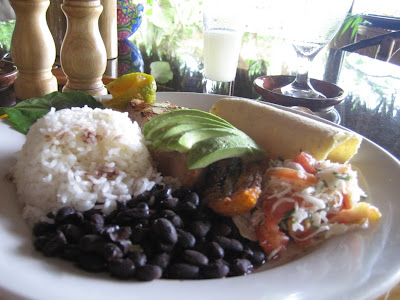After the hike, we had the juice of the day: guanábana - yummy, and the chip of the day: yucca - good.

This guy wasn't on the menu, just curious...

Another postcard view, on our walk back to the bungalow...
We washed up and had lunch: casado with tuna (below) and yuccassoise (the yucca version of French potato leek soup). Fruit for dessert.

While having lunch, we saw a green snake with a blue tongue slither across the deck.

We paged through a book on Costa Rican animals before going back to our bungalow to change for Nick's surf lesson.
The lesson was with Oldemar "Pollo" of Tres Peces Surf School at Pan Dulce at 3:30. We were told it's a 15 minute walk; however, just as we were leaving, the Lapa Rios truck that was departing backed up and asked us if we needed a ride. The family from Dallas we flew in with was also heading out for the surf lesson. This was a good thing, as I don't think we would have found the spot on the beach where we were supposed to go, and it would have taken us much longer than 15 minutes to get there.
It's a bumpy road to the beach. The beach is rockier than those we've seen previously and doesn't seem pleasant to swim in. Pretty though. Green-blue water, brown-grey sand, jungle backdrop. Nick, along with the husband, son, and daughter of the family proceeded to the surf lesson while the wife of the family and I watched and took pictures.
Nick thoroughly enjoyed this. I caught a few pics of him riding the waves. Here's one.

I also made fast friends with a very photogenic pelican.





The Lapa Rios truck picked us up at 5:30, and we headed back to wash our feet outside of our bungalow then went back to the main lodge to see the bats take off for the night. When we got there, 5 were still there (they'd been 11 during the day). We shined the flashlight on them to see them better, and they all in turn flew down in a matter of minutes. [We really shouldn't have disturbed them with the flashlight.]
We then sat outside on the deck by the restaurant and watched the bats flitting by. They appeared larger than all of the previous ones we'd seen. Then we went back to the bungalow, showered, and headed to dinner.


They have this drink called the Pink Iguana. YUM-MY!!! The circle of lime forms the eye and the wooden stirrer makes the tongue. Mmmm! Tastes like cottoncandy snowcones!

Afterthought: it rained a bit today. Some thunder and lightning.
next post > day 12 - Lapa Rios Flora & Fauna
previous post > day 11 - Lapa Rios Osa Trail
first post > day 1 - Adventure, Exploration and Relaxation

This guy wasn't on the menu, just curious...

Another postcard view, on our walk back to the bungalow...
We washed up and had lunch: casado with tuna (below) and yuccassoise (the yucca version of French potato leek soup). Fruit for dessert.

While having lunch, we saw a green snake with a blue tongue slither across the deck.

We paged through a book on Costa Rican animals before going back to our bungalow to change for Nick's surf lesson.
* * *
The lesson was with Oldemar "Pollo" of Tres Peces Surf School at Pan Dulce at 3:30. We were told it's a 15 minute walk; however, just as we were leaving, the Lapa Rios truck that was departing backed up and asked us if we needed a ride. The family from Dallas we flew in with was also heading out for the surf lesson. This was a good thing, as I don't think we would have found the spot on the beach where we were supposed to go, and it would have taken us much longer than 15 minutes to get there.
It's a bumpy road to the beach. The beach is rockier than those we've seen previously and doesn't seem pleasant to swim in. Pretty though. Green-blue water, brown-grey sand, jungle backdrop. Nick, along with the husband, son, and daughter of the family proceeded to the surf lesson while the wife of the family and I watched and took pictures.
Nick thoroughly enjoyed this. I caught a few pics of him riding the waves. Here's one.

I also made fast friends with a very photogenic pelican.





The Lapa Rios truck picked us up at 5:30, and we headed back to wash our feet outside of our bungalow then went back to the main lodge to see the bats take off for the night. When we got there, 5 were still there (they'd been 11 during the day). We shined the flashlight on them to see them better, and they all in turn flew down in a matter of minutes. [We really shouldn't have disturbed them with the flashlight.]
We then sat outside on the deck by the restaurant and watched the bats flitting by. They appeared larger than all of the previous ones we'd seen. Then we went back to the bungalow, showered, and headed to dinner.


They have this drink called the Pink Iguana. YUM-MY!!! The circle of lime forms the eye and the wooden stirrer makes the tongue. Mmmm! Tastes like cottoncandy snowcones!

* * *
Afterthought: it rained a bit today. Some thunder and lightning.
next post > day 12 - Lapa Rios Flora & Fauna
previous post > day 11 - Lapa Rios Osa Trail
first post > day 1 - Adventure, Exploration and Relaxation

Comments
Post a Comment